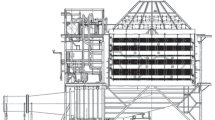Abstract
The article presents the results of the experimental study of heat and mass transfer processes in an NPP steam generator during the operation of passive safety systems of new-generation VVER reactor installations. At the GE2M-PG test rig in the Leypunsky Institute for Physics and Power Engineering, two series of experiments corresponding to different stages of the accident were completed. In these experiments, the performance of VVER steam generator in the condensing mode with and without the removal of gas-vapor mixture from the “cold” header has been studied. As a result of the first series of experiments, it was found that, for any of the parameters of the emergency process, the steam generator’s power does not drop below 80% of the original value. Furthermore, we revealed that the composition and physical properties of gases in the investigated concentration range did not notably affect the processes in the steam generator. In the second series of experiments without removal of noncondensable gases, the influence of parameters of the emergency process on the efficiency of heat transfer in the steam generator operating in the condensing mode was investigated. In order to study the heat transfer processes, we studied the change of the temperature difference between the media of the first and second circuits in our experiments. We found that the value of the temperature difference depends on both the mass of noncondensable gases accumulated in the tube bundle and their accumulation rate. The accumulation rate is determined by the power of the steam generator and the concentration of gases entering the steam generator. As a result of the analysis of experimental data, we obtained the analytical dependence reflecting change in the power of the steam generator operating in the emergency condensing mode.
Similar content being viewed by others
References
I. I. Kopytov, S. G. Kalyakin, V. M. Berkovich, A. V. Morozov, and O. V. Remizov, “Experimental investigation of non-condensable gases effect on Novovoronezh NPP-2 steam generator condensation power under the condition of passive safety systems operation,” in Proc. 17th Int. Conf. on Nuclear Engineering (ICONE17), Brussels, July 12–16, 2009 (Am. Soc. Mech. Eng., 2009), Vol. 2, pp. 735–743.
S. G. Kalyakin, A. P. Sorokin, V. A. Pivovarov, R. S. Pomet’ko, Yu. F. Selivanov, A. V. Morozov, and O. V. Remizov, “Experimental research on thermophysical processes for safety validation of new-generation VVER” At. Energy 116, 293–299 (2014).
A. V. Morozov, O. V. Remizov, and A. A. Tsyganok, “Non-condensable gases effect on heat transfer processes between condensing steam and boiling water in heat exchanger with multirow horizontal tube bundle,” in Proc. 14th Int. Heat Transfer Conf. (IHTC14), Washington, DC, Aug. 8–13, 2010 (Am. Soc. Mech. Eng., 2010), Vol. 4, pp. 629–635.
D. F. Othmer, “The condensation of steam,” Ind. Eng. Chem. 21, 577–583 (1929).
L. D. Berman, “Heat and mass transfer during vapor condensation in presence of non-condensable gases,” Izv. Vses. Teplotekh. Inst., No. 8, 11–18 (1947).
I. K. Vierow and V. E. Schrock, “Condensation in a natural circulation loop with noncondensable gases. Part I: Heat transfer,” in Proc. Int. Conf. on Multiphase Flows (ICMF '91), Tsukuba, Japan, Sept. 24–27, 1991, Vol. 1, pp. 183–186.
S. Alt, A. Fjodorov, and W. Lischke, “Steam condensation processes in horizontal tubes with presence of noncondensing gases,” in Proc. 5th Int. Conf. on Nuclear Engineering (ICONE5), Nice, France, May 26–30, 1997 (Am. Soc. Mech. Eng., New York, 1997).
A. V. Morozov and O. V. Remizov, “An experimental substantiation of the design functions imposed on the additional system for passively flooding the core of a VVER reactor,” Therm. Eng. 59, 365–370 (2012).
A. V. Morozov and O. V. Remizov, “An experimental study of a VVER reactor’s steam generator model operating in the condensing mode,” Therm. Eng. 59, 359–364 (2012).
V. M. Berkovich, V. G. Peresadko, G. S. Taranov, O. V. Remizov, A. V. Morozov, A. A. Tsyganok, and D. S. Kalyakin, “Experimental study on Novovoronezh NPP-2 steam generator model condensation power in the event of the beyond design basis accident,” in Proc. Int. Congr. on Advances in Nuclear Power Plants (ICAPP 2010), San Diego, CA, June 13–17, 2010 (Am. Nucl. Soc., 2010), Vol. 1, P. 186–192.
V. M. Berkovich, I. I. Kopytov, G. S. Taranov, and M. B. Mal’tsev, “Salient features of the design for a new generation nuclear power station equipped with a VVER-1000 reactor having enhanced safety,” Therm. Eng. 52, 9–16 (2005).
Author information
Authors and Affiliations
Corresponding author
Additional information
Original Russian Text © A.V. Morozov, A.S. Shlepkin, D.S. Kalyakin, A.S. Soshkina, 2017, published in Teploenergetika.
Rights and permissions
About this article
Cite this article
Morozov, A.V., Shlepkin, A.S., Kalyakin, D.S. et al. Studying the operation of a VVER steam generator in the condensing mode at different parameters of emergency processes. Therm. Eng. 64, 329–335 (2017). https://doi.org/10.1134/S0040601517050044
Received:
Accepted:
Published:
Issue Date:
DOI: https://doi.org/10.1134/S0040601517050044




